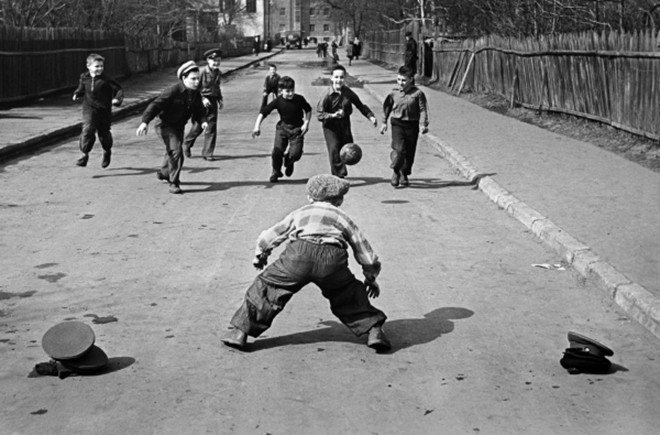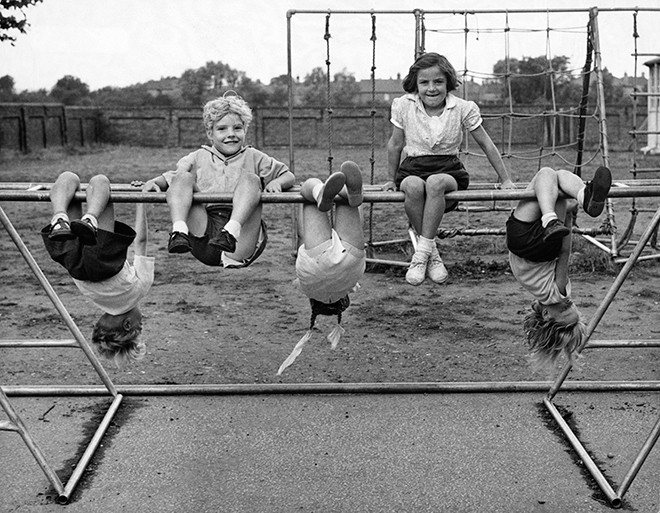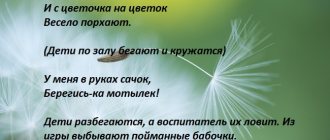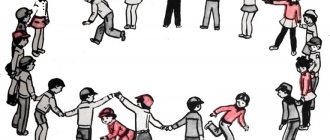"Twelve Sticks"
One of the varieties of hide and seek, but with an interesting complication. Before the start of the game, participants choose a driver and build a special structure: a board is laid on a stone, brick or other object of suitable size so that one end of it lies on the ground and the other is raised up. Twelve small sticks are placed on the lower end of the board (pencils or brushwood can be used), and then, using the board as a lever, one of the participants scatters them. While the driver collects sticks, the players hide. Then, as in standard hide and seek, he goes to look for those hiding and, if he finds them, he snitches, that is, he runs to the base. Or, as the driver’s place was previously called, to the “con” or “fat”. and shouts something like “Knock-knock for Petya!” The essence of the complication is that during the search you must not forget to guard the structure made of sticks: the discovered player can run to the board before the driver and destroy everything (at the same time he must shout: “I broke it!”). Any other player can do the same if he notices from cover that no one is guarding the base. If the sticks are scattered, then the driver must give up searching and reinstall the structure, and the one who scattered the sticks and the other players hide at this time. It is quite difficult to get rid of the role of the driver in such a game.
"I know five names"
The first player hits the ball from the ground with his hand, while saying: “I know five names of girls: Katya, Tanya, Sveta, Olya, Yulia...” You must speak quickly and rhythmically, for each word you must hit the ball with your hand. If the player is not lost, he continues: “I know five names of boys: Vanya, Kolya, Petya, Sasha, Misha...” Then, in the same way, you can continue to name five of everything that comes to mind: the names of cities, rivers, animals, trees, birds, car brands (some determine the sequence in advance, others create it on the fly). If a player loses the ball, makes a mistake, or takes too long to come up with an option, then the ball is passed to the second player, and he starts over: “I know five names of girls...” Repeating the same names and names is not interesting! When the ball, having made a circle, returns to the first player, he starts from the topic on which he lost his way. You can play “I Know...” not only with a group, but also with two people or even alone.
Cossack robbers
This game has been known at least since the mid-19th century. It had different names (“Cossacks and Bashkirs”, “Russians and Chechens”, etc.), but the essence of the game in both the 19th and 20th centuries came down to approximately the same thing: participants are divided into two teams, one of which it hides, and the second searches for and attacks those hiding. In the most famous version, Cossack-robbers are similar to team hide-and-seek: the searching team (Cossacks) counts down the time, while the other (robbers) comes up with a secret password and runs away, leaving traces along the way - arrows drawn in chalk on the asphalt, indicating the direction of their movement. Those running away try to confuse their opponents: they draw arrows very pale, in inconspicuous places; At intersections they draw a cross with four arrows so that pursuers do not know where to turn. The robbers hide for 10–15 minutes, during which time the Cossacks determine the dungeon - the place where they will torture the other team to find out the password (it is worth agreeing on the methods of torture in advance: the most humane thing is to tickle or force them to squat). If the Cossacks find out the password, they win. According to some rules, captured robbers can be released: members of one team attack the Cossack guard and hold him, the prisoners scatter (the guard can scream and call for help). This variant of the game is also known: the password word is guessed according to the number of robbers (for example, 7 players - 7 letters), each is given a letter. The robber in the dungeon is obliged to tell the Cossacks his letter, and recovering the password becomes easier and more interesting.
"Stander"
A half-forgotten game from the repertoire of pioneer camps. Judging by the name (most likely from Ständer! - “Stand!”), it was borrowed from a German game collection. To play you will need a ball. A large circle is drawn on the ground - all participants must fit into it. Then one person tosses the ball, calling the name of any other player. Everyone runs in different directions, and the named player leads. He catches or quickly picks up the ball from the ground, after which he shouts: “Stander!” - and everyone else must stop. The driver needs to knock someone out with the ball: he chooses his target (usually the player who is closest to him), takes three steps towards him and tries to hit him. He can cheat and step in one direction and throw the ball in the other so that the unsuspecting player does not have time to dodge. If the driver hits, then the “beaten” one receives a penalty point; if not, the driver gets a penalty point. In the next horse, the same driver throws the ball and calls the name of the player who will take his place. At the end of the game, the points are added up and the one with the least is declared the winner.
"Ring"
This game is very old, known as "Bury Gold" since at least the early 19th century, but most likely existed much earlier. The game “Burying Gold” was part of the Yuletide entertainment for young people, especially girls: the song that accompanied the action was filled with marriage images (a tower, a viburnum-raspberry, a light brown braid, a ring falling to a young nobleman) The lyrics of the song were, for example, like this : “I’m already gold / I’m burying, I’m burying, / I’m burying pure silver. / I’m with my father in the mansion, in the mansion, / I’m with my mother in the high, high. / The ring fell, the ring fell / Into the viburnum-raspberries, / Black currants; / The ring ended up / Yes with the nobleman, / Yes with the young man / On the right hand, / On the right little finger. / Guess, guess, girl, / In which hand was the girl, / Walking across the field, / Weaving a braid into Russia, / Weaving in silk, / Weaving in gold, / The girl was guessing, but didn’t guess. / You are my girlfriends, you are mine, you are mine, / You tell me, don’t hide, / Give me my gold: / My mother will beat me / Three mornings, four, / Three golden rods, / Fourth pearl. / The girls guessed, but didn’t guess; / Gentlemen of the nobility, guess for yourself” (A. V. Balov. “Russian round dance”. Round dance games in the Yaroslavl province / Northern Bulletin. St. Petersburg, 1889. No. 6). and could be performed during fortune telling. By the end of the 20th century, the game lost the long song, the connection with Christmas time and the magical meaning, only the action and the name of the game item remained - the ring. Although a ring is not necessary: “Ring” can be played with any small object - a coin, a button, a paper clip, etc. Participants sit in a row, fold their palms like shell flaps, and hold them in front of them. The driver, who has a “ring” in his hands folded in the same way, approaches everyone in turn and lowers his hands into the player’s hands. He places a “ring” in the hands of one of the players, trying to do it unnoticed. The one who got the “ring” also tries not to give himself away. The others, in turn, watch carefully, noticing who is behaving unusually and suspiciously. After all the players have been bypassed, the driver steps aside and says: “Ring-ring, go out onto the porch!” The player with the “ring” quickly jumps up and runs towards him. Other players, especially if they realized in advance who has the “ring,” try to grab it and hold it in place. If the player with the “ring” manages to escape, then he leads the next horse; if not, the previous player remains leading.
At the playground. 1981 © Vitaly Karpov / RIA Novosti
"Potato"
The players stand in a wide circle and throw the ball to each other. You can’t hold it in your hands: the ball is a hot potato! Those who could not hold the ball in their hands and let it fall to the ground also turn into “potatoes”: they go to the center of the circle and squat down there. The remaining players from time to time “spud” them, that is, they accurately throw the ball at those sitting (it is better to agree on the force of the impact before the game). The potato needs to catch the ball in the air - but you can’t stand up to your full height, you can only jump without straightening your knees. If you succeed in catching the ball, the potato stands in the circle again, and the player whose throw the ball was caught takes its place in the center.

Children play with a ball on the street. Moscow, 1959 © RIA Novosti
"Water"
A type of blind man's buff that is suitable for limited courtyard spaces - a delineated area, an area in front of a house with a fence. Players choose a driver - a merman. He squats down, blindfolds his eyes and hides his face in his knees, the others put their hands on his head and walk around saying: “Water-Water, why are you sitting under water? Come out for a minute, just a second!” Having finished reading the poem, everyone scatters in different directions, and the driver stands up and shouts: “Stop!” Players freeze in the place where the team caught them and must not move from it. Trying to dodge the hands of the driver, they can squat, lean in different directions, or stand on one leg. Having grabbed the player, the driver must recognize him by touch and call him by name. The caught player leads the next horse. The merman, with his eyes closed, looks for players, focusing on sounds, so the players try to stand as quietly as possible, without puffing or laughing (which is quite difficult!).
"Traffic light"
On the site, two lines are drawn at a distance of 3–6 meters from each other - a road passes between them. The driver - the traffic light - stands in the middle of the road and cannot go beyond the lines. The rest are in front of the first line, and their task is to cross to the other side, that is, to end up behind the opposite line. The traffic light stands with its back to the players and makes a guess about the color: for example, it announces that it will only let red into the other side. Each player begins to look for some red thing on himself; its size and purpose are not important, and even a small spot on the pattern can be red. After some time (for example, after counting to ten), the driver turns around, and those who managed to find the right color present it to the traffic light and calmly cross the road. Everyone else is trying to run to the other side, but the traffic light catches them. The one he caught becomes the new traffic light. It makes sense for the driver to name unusual colors - lilac, turquoise, etc.: then there will be more of those who do not find such a color on themselves - and he will be able to catch a player to replace him.
Confusion
The driver steps aside and turns away. Participants stand in a circle facing each other, hold hands and begin to get entangled: someone crawls under someone else’s hands, someone steps over their neighbor’s hands, someone turns around themselves - all this must be done without uncoupling. After the players decide that they are sufficiently confused - usually by this time they are already standing close to each other, intertwined with their arms and legs - they call the driver, who must untangle them. You need to unravel it in such a way that the knot turns back into a circle, while the hands of the players cannot be separated. The point of the game is more about interest than about the victory of the driver or the “confused” people, so it is recommended to give the driver tips. In some variants, if the chain of players breaks during untangling, they run away and the driver catches them, as in a catch-up game.

Children on the school playground. England, 20th century © Hulton-Deutsch Collection / Corbis / Getty Images
"Granny's pantaloons"
Participants sit in a row. The driver tells, composing as he goes, a story, for example: “I got up early this morning, looked out the window, and in the sky...” - at a key moment he falls silent, giving the floor to one of the players in turn. Players must say the same thing every time - “grandmother’s pantaloons”:
- I washed my face, dressed in... -... my grandmother’s trousers. - And went for a walk. I came to the forest, and there on the tree... -...grandmother's pantaloons.
And so on. In another version, the driver does not tell, but asks the players one by one questions:
- What's in your backpack? - Grandma's trousers.
At the same time, none of the players should laugh - this is quite difficult. The one who laughed changes the driver and leads the story further.








